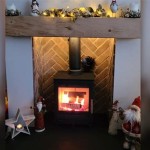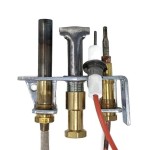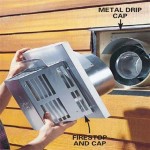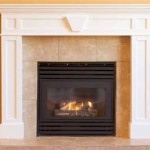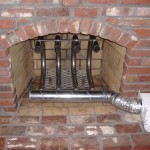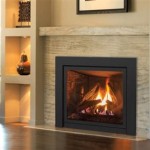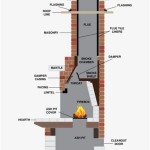```html
Gas Fireplace Surround: A Comprehensive Guide
A gas fireplace surround is a decorative structure built around a gas fireplace insert or unit. It serves both aesthetic and functional purposes, enhancing the visual appeal of the fireplace while also providing a safety barrier and improving the overall efficiency of the heating appliance. Choosing the right gas fireplace surround requires careful consideration of style, materials, size, and safety regulations.
The surround typically consists of a frame, a facing material, and sometimes a hearth. The frame provides the structural support, while the facing material, such as stone, brick, tile, or wood, determines the aesthetic of the fireplace. The hearth, a non-combustible surface extending in front of the fireplace, protects the flooring from heat and embers (though less critical with gas fireplaces compared to wood-burning ones).
Installing a gas fireplace surround is a project that can often be undertaken by homeowners with some DIY experience. However, due to the complexities involved with gas lines and ensuring compliance with building codes, consulting with and possibly hiring a qualified professional is highly recommended. This is particularly important when dealing with gas line modifications or when installing surrounds that deviate significantly from manufacturer recommendations.
Key Point 1: Aesthetic Considerations and Design Styles
The aesthetic impact of a gas fireplace surround is significant. It transforms a functional heating appliance into a focal point within a room. The design choices are vast, offering options to complement a variety of interior styles, from traditional to contemporary and everything in between.
Traditional fireplace surrounds often feature ornate details, such as carved wood, intricate moldings, and classic marble or stone. These surrounds evoke a sense of history and elegance, creating a cozy and inviting atmosphere. Common materials include hardwood like oak or maple, and natural stones like marble or granite. The color palettes tend to be warm and neutral, often featuring earth tones and rich browns.
Contemporary fireplace surrounds, on the other hand, emphasize clean lines, minimalist designs, and modern materials. These surrounds often incorporate materials like stainless steel, glass, and concrete, creating a sleek and sophisticated look. The color palettes are typically more subdued, featuring grays, whites, and blacks. Linear fireplace designs are particularly popular in contemporary settings, offering a panoramic view of the flames.
Transitional fireplace surrounds bridge the gap between traditional and contemporary styles, blending classic elements with modern sensibilities. These surrounds often incorporate a mix of materials, such as wood and stone, creating a balanced and harmonious look. The color palettes tend to be versatile, allowing for a wide range of options to complement different interior styles. The key is to balance ornate details with clean lines to avoid overwhelming the space.
Beyond these broad categories, numerous niche styles exist. Rustic fireplace surrounds often feature reclaimed wood, exposed brick, and natural stone, creating a warm and inviting atmosphere reminiscent of a country cottage or a mountain lodge. Farmhouse fireplace surrounds share similar characteristics but often incorporate lighter colors and shiplap detailing. Industrial fireplace surrounds emphasize raw materials, such as exposed metal and concrete, creating a gritty and urban aesthetic.
The choice of design style ultimately depends on personal preferences and the overall aesthetic of the room. It's crucial to consider the existing architecture, furniture, and color scheme to ensure that the fireplace surround seamlessly integrates into the space.
Key Point 2: Material Selection and Performance Characteristics
The materials used for a gas fireplace surround play a significant role in its appearance, durability, and performance. Different materials offer varying degrees of heat resistance, maintenance requirements, and aesthetic appeal. Careful consideration of these factors is essential when selecting the appropriate materials for a gas fireplace surround.
Stone is a popular choice for fireplace surrounds due to its natural beauty, durability, and heat resistance. Natural stone options include granite, marble, limestone, and slate. Each type of stone offers a unique texture, color, and pattern, allowing for a wide range of design possibilities. Stone is also relatively low-maintenance, requiring only occasional cleaning to maintain its appearance. However, natural stone can be expensive and heavy, requiring professional installation.
Brick is another classic choice for fireplace surrounds, offering a rustic and timeless appeal. Brick is durable, heat-resistant, and relatively affordable. It can be painted or stained to match different color schemes. However, brick can be porous, requiring sealing to prevent moisture damage. Also, the traditional appearance of brick might not suit all design styles.
Tile is a versatile option for fireplace surrounds, offering a wide range of colors, patterns, and textures. Tile is durable, heat-resistant, and easy to clean. It can be used to create intricate designs and patterns, adding visual interest to the fireplace surround. Common tile options include ceramic, porcelain, and glass. However, tile can be susceptible to cracking if not installed properly.
Wood is a popular choice for framing and decorative accents in fireplace surrounds, but it's crucial to select appropriate wood species and finishes to ensure safety and durability. Hardwoods like oak, maple, and cherry are commonly used for framing, while heat-resistant finishes are applied to protect the wood from heat damage. Wood surrounds can add warmth and character to a room, but they require regular maintenance to prevent warping or cracking. It's critical to adhere to clearance requirements from the fireplace opening for combustible materials specified by the fireplace manufacturer.
Metal, such as stainless steel or cast iron, is often used in contemporary fireplace surrounds, offering a sleek and modern look. Metal is durable, heat-resistant, and easy to clean. It can be used to create clean lines and geometric shapes. However, metal can be expensive and may require specialized installation techniques.
Concrete is gaining popularity as a material for modern fireplace surrounds. Its industrial aesthetic and ability to be molded into unique shapes make it a desirable choice. Concrete is durable and fire-resistant, but it can be porous and require sealing.
Key Point 3: Safety Regulations and Installation Procedures
Safety is paramount when installing a gas fireplace surround. Adhering to local building codes and manufacturer's instructions is crucial to prevent fire hazards and ensure the safe operation of the fireplace. Improper installation can lead to serious consequences, including property damage and personal injury.
Local building codes typically specify minimum clearances for combustible materials around the fireplace opening. These clearances vary depending on the type of fireplace and the materials used for the surround. It's essential to consult with local building officials or a qualified contractor to ensure compliance with all applicable regulations.
Manufacturer's instructions provide detailed guidelines for installing the fireplace surround, including recommended materials, installation procedures, and safety precautions. Following these instructions carefully is essential to ensure the safe and proper operation of the fireplace. Deviating from the manufacturer's instructions can void the warranty and potentially create a hazardous situation.
Gas line connections should be handled by a qualified and licensed gas fitter. Improper gas line connections can lead to gas leaks, which can be extremely dangerous. Never attempt to repair or modify gas lines without the proper training and certifications.
Ventilation is another critical aspect of gas fireplace safety. Proper ventilation is essential to prevent the buildup of carbon monoxide, a colorless and odorless gas that can be deadly. Ensure that the fireplace is properly vented according to the manufacturer's instructions. Carbon monoxide detectors should be installed in the vicinity of the fireplace to provide early warning of any potential gas leaks.
The installation process typically involves building a frame around the fireplace opening, attaching the facing material to the frame, and sealing any gaps or cracks. The hearth, if included, is typically installed first, followed by the frame and facing material. It's essential to use appropriate fasteners and adhesives to ensure that the surround is securely attached to the wall.
After installation, it's crucial to inspect the gas fireplace and surround to ensure that everything is functioning properly. Check for gas leaks, proper ventilation, and any signs of damage or wear. A professional inspection by a qualified technician is recommended to ensure that the fireplace is operating safely and efficiently.
```
7 Fireplace Surround Ideas That Will Ignite The Room

Gas Fireplace Surround Contemporary Living Room New York By Trueform Concrete Llc Houzz

Types Of Fireplaces And Mantels The Home Depot

Chesneys Dakota Limestone Fireplace Surround Bonfire

Gas Fire Wooden Fireplace Surround Installation Watford Rigbys

Jeff S Stone Veneer Gas Fireplace Surround Genstone

Gas Fireplace Design Ideas S Remodel And Decor Contemporary Home

Rochester Solid Oak Gas Fireplace Full Package Fire Surrounds

How To Install A Gas Fireplace Framing Finishing Tylynn M

Diy Faux Plaster Fireplace Surround Chelsey Freng
Related Posts

